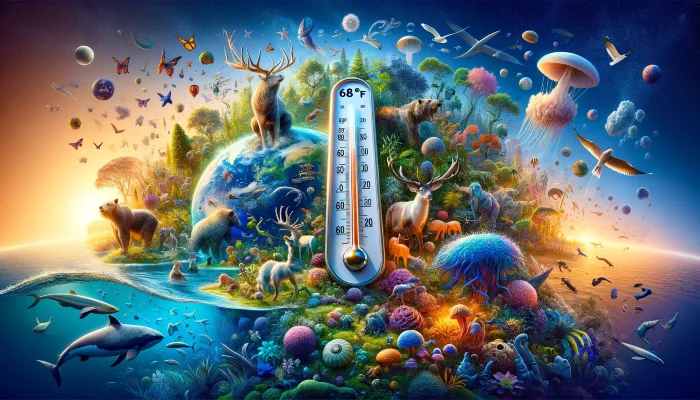Scientists have pinpointed 68°F, (20°C) as the universal sweet spot for life on Earth. This isn’t just about human comfort. It’s where the magic happens for animals, plants, and microbes alike.
A Global Consensus
Across the globe, from icy waters to warm soils, life thrives most at 20°C (68°F). This temperature emerges as a common denominator for diverse life forms, including those in air and water. It’s not just a happy coincidence. It’s a pattern that repeats, pointing to 20°C as the optimal temperature for biological processes.
Beyond Coincidence
The relationship between life and temperature forms an asymmetric bell-shaped curve. As temperatures climb, biological activities increase, peaking at 20°C before dropping sharply. This pattern is consistent across the board, from marine species to terrestrial plants and microbes.
Subtropical Surprises
Contrary to old beliefs, marine biodiversity doesn’t peak at the equator but dips, flourishing instead in subtropical regions. Studies reveal this trend has been intensifying since the last ice age and is accelerating with global warming. The common factor? A decline in species diversity above 20°C.
The Corkrey Model
In Tasmania, research on microbes and multicellular organisms revealed that 20°C supports the most stable growth rates. This “Corkrey model” echoes findings that 20°C stabilizes biological molecules, hinting at a deeper, universal principle governing life.
Collaborating internationally, researchers uncovered that 20°C is a pivot for biodiversity. This temperature marks a limit; beyond it, there’s a decrease in species’ tolerance, productivity, and even genetic diversity. The fossil record backs this up, showing fewer extinctions at this optimal temperature.
More To Discover
- Hermit Crabs’ New Plastic Address: A Sad Sight on Tropical Shores
- Texas A&M Researchers Explore Black Soldier Fly’s Potential in Tackling State’s Manure Issue
- Flatpacked Forests: Ikea’s Timber Controversy and the Flaws in FSC Certification
- The Battle Against Invasive Carp: The Solution Is Simple, Eat The Invaders
Richness at 20°C
Life, in its myriad forms, seems to favor 20°C. The diversity of reef fishes, invertebrates, and even microbes is greatest at this temperature. The fossil record shows lower extinction rates for a wide range of species at 20°C, supporting the notion of it as a biodiversity hotspot.
Climate Change Implications
The discovery that life’s sweet spot is at 20°C highlights the challenges tropical species face with global warming. While marine species might adapt by shifting their ranges, terrestrial species are constrained by human-altered landscapes. This 20°C benchmark could shape our understanding of how ecosystems respond to climate change, offering insights into biodiversity, species distribution, and the very evolution of life on Earth.
The Molecular Secret
The preference for 20°C may stem from the molecular properties of water, crucial for cellular processes. This temperature maximizes efficiency and supports a rich tapestry of life. With the world warming, understanding this 20°C effect is vital for predicting and mitigating the impacts of climate change on global biodiversity.



















